#the extinct American cheetah is not that closely related to the modern cheetah
Text
God it pains me every time I see misinfo being spread on topics and knowing I won’t be able to really change peoples mind or catch everyone who has been misinformed
#the extinct American cheetah is not that closely related to the modern cheetah#our idea that they were really fast and likely hunted pronghorn is based on a LOT of assumptions#they’ve found some American cheetahs that would’ve behaved more like snow leopards. there’s a lot we still don’t know#and it’s all based on fossils which we can make some really good assumptions about#but it’s not hard fact and we rarely know exactly what prey animals a predator fed on#that said I love cheetahs and i want all the info on extinct cats#hana talks
3 notes
·
View notes
Text
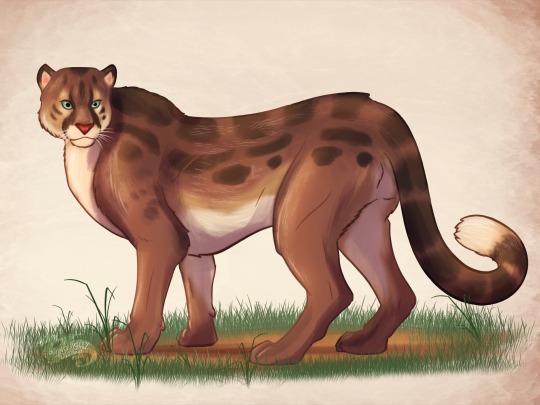
For today’s #FossilFriday, Miracinonyx, the so-called American Cheetah! While related to African Cheetahs and sharing many similarities, the American Cheetah is more closely related to modern pumas, and in life was much more of a generalist hunter than African Cheetahs. Nevertheless, it’s widely held that the American Cheetah was what pushed the Pronghorn Antelope into becoming the fastest land mammal in North America, a position it still holds despite the cat going extinct around twelve thousand years ago.
#American cheetah#cheetah#puma#cougar#mountain lion#pleistocene#ice age#prehistoric#fossil friday#illustration#paleontology#paleo art#procreate#artist on tumblr#mammal#cat
52 notes
·
View notes
Text
New Feathered Carnivorous Dinosaur Found in New Mexico
https://sciencespies.com/nature/new-feathered-carnivorous-dinosaur-found-in-new-mexico/
New Feathered Carnivorous Dinosaur Found in New Mexico

A new carnivorous feathered dinosaur, coyote-sized with razor-sharp teeth and claws, has been discovered in New Mexico’s San Juan Basin. The small but formidable predator called Dineobellator would have stalked these open floodplains 70 million years ago.
Steven Jasinski, a paleontologist at the State Museum of Pennsylvania and lead author of the study in Scientific Reports, says Dineobellator is a new species from the Late Cretaceous (70-68 million years ago) that belongs to dromaeosaurid, a group of clawed predators closely related to birds. These rare fossils have features that suggest raptors were still trying out new ways to compete even during the dinosaurs’ last stand—the era just before the extinction event that wiped them out 66 million years ago. “This group was still evolving, testing out new evolutionary pathways, right at the very end before we lost them,” Jasinski notes.
The bones from this new specimen bear the scars of a combative lifestyle and suggest some unusual adaptations of tail and claw that might have helped Dineobellator notohesperus hunt and kill. The name Dineobellator pays homage to the dino’s tenacity and that of the local Native American people. Diné means ‘the Navajo people,’ while bellator is the Latin word for warrior.
“Due to their small size and delicate bones, skeletons of raptors like Dineobellator are extremely rare in North America, particularly in the last 5 million years of the Age of Dinosaurs,” says David Evans, a paleontologist at the Royal Ontario Museum and the University of Toronto, who wasn’t involved in the study. “Even though it is fragmentary, the skeleton of Dineobellator is one of the best specimens known from North America for its time, which makes it scientifically important and exciting.”

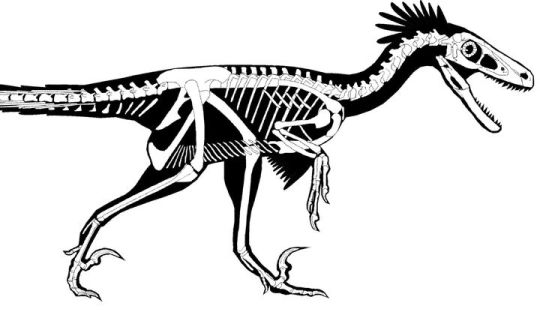


Dineobellator notohesperus outline and skeletal reconstruction.
(Steven Jasinski)
Over four field seasons between 2008 and 2016, Jasinski and colleagues unearthed 20 fossils from a single creature’s skeleton, including parts of the skull, teeth, fore and hind legs, ribs and vertebrae. Dineobellator’s forearms feature quill knobs, bumps found on the bones of dinosaurs or birds that reveal where feathers once attached. Like its relative Velociraptor, this newfound animal was about the size of a coyote or large barnyard turkey, Jasinski says, but probably punched above its weight as a predator.
The fossils indicate the dinosaur suffered a rib injury, but bone regrowth shows that it survived and healed. But this Dineobellator wasn’t so fortunate with an injury to its hand claw. “The hand claw injury doesn’t show any bone regrowth, so it looks like it happened either right at death or just before,” Jasinski says.
Dineobellator’s unusual features include its forelimbs, which appear to be an uncommon shape that would have maximized muscle power to make them very strong, a trait Jasinski suggests was accentuated by claws on both hands and feet. “Their grip would have been far stronger than what we see in the other members of this group,” he says.
Fossils from the animal’s tail also suggest an intriguing anatomy. Most similar dinosaurs have stiff tails reinforced with bones or tendons that would have helped with balance and aided running. “What these animals have … is a lot of mobility at the base of the tail where it attaches to the hips,” Jasinski says. “If you think about how a cheetah attacks, their tail is whipping all over the place because they have to change directions very quickly so it increases agility. That’s what this animal would have been able to do, that others in its group would not. It makes this animal agile and a very good pursuit predator.”

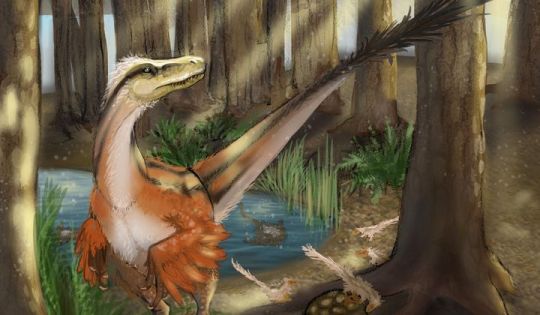


Reconstruction of Dineobellator notohesperus standing over a nest by Mary P. Williams
(Steven Jasinski)
Paleontologist Alan Turner, of the American Museum of Natural History and Stony Brook University, cautions that without a full skeleton, the remains are too fragmentary and scattered to make serious inferences about Dineobellator’s tail or claws. “A couple of vertebrae do give you a glimpse of what the tail looked like, but if you don’t have an entire tail, or the part of the backbone that the tail attaches to, I’d be reticent to make a definitive statement about tail mobility.” But, he says, this study fills in gaps for a period that’s lacking in samples and offers a glimpse into the dromeosaurs of the time.
David Evans echoed that point. “More complete fossils and comparative functional analyses are needed to demonstrate whether Dineobellator was a particularly strong or adept predator. Dineobellator shows us more skeletons are out there, waiting to be found,” he says.
Evans agrees with the study authors that the fossils in hand demonstrate that close relatives of Velociraptor were diversifying during the last days of the Age of the Dinosaurs. “Importantly, it shows that the raptors in the southern part of western North America were distinct from those in the north, and suggests these differences may have been driven by different local ecosystem conditions.”
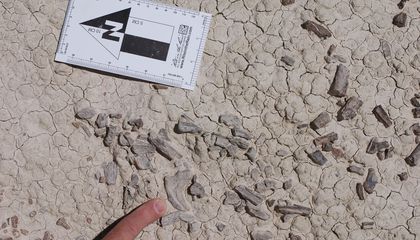
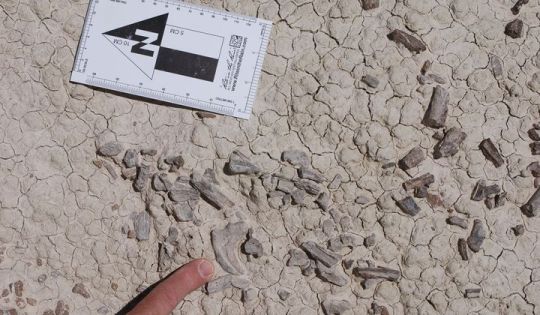
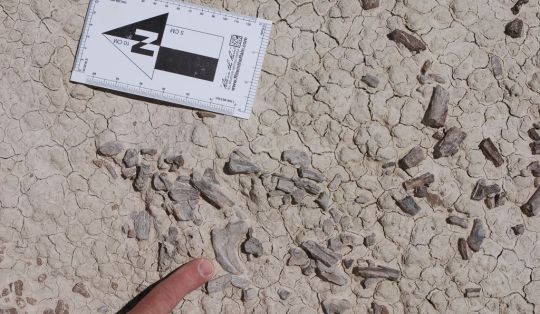

Photo from the original discovery of Dineobellator notohesperus pointing out the hand claw among other bone fragments
(Steven Jasinski)
Other excavations have given scientists a reasonably good idea of the menagerie of animals that shared Dineobellator’s ecosystem, an open floodplain habitat in modern-day New Mexico that was growing increasingly distant from the receding shoreline of the Western Interior Seaway.
Ojoceratops, a horned beast very much like Triceratops, was fairly common as was long-necked sauropod Alamosaurus. “We have evidence of a small tyrannosaurid, something like T. rex but considerably smaller,” Jasinski says. “There are duck-billed dinosaurs, hadrosaurids, that are relatively common, there are lots of turtles, crocodilians have been common all over the place, and evidence of early birds there as well that would have been living with this thing.”
As for how Dineobellator and its kin fit in, Turner says that’s a matter of speculation. “Just size-wise, your average North American or Asian dromeosaur might be along the lines of foxes or coyotes,” he notes, adding that like those mammals, Dineobellator might have existed in substantial numbers as a kind of ubiquitous predator. “That sort of general predatory niche is probably where a lot of these dromeosaurs were falling out.”
While the individual Dineobellator in the study appears to have met a violent end it seems likely that it and its relatives also enjoyed their share of success. “They have sharp teeth and nasty claws on their feet,” Turner notes. “They aren’t these big intimidating things, but I still wouldn’t want to have a run-in with one.”
#Nature
2 notes
·
View notes
Photo

SHUNKA WARAK’IN, or RINGDOCUS- MONTANA
Until just a few thousand years ago there was considerably more megafauna diversity in North America than there is today. Most famous of these large Pleistocene mammals, of course, were the mammoths, mastodons and sabertooth cats. But there were many more, as well. Camels and horses. Giant ground sloths. American cheetahs (actually more closely related to pumas than African cheetahs). Hell pigs. A Shovel-tusked elephant called Amebelodon. Beavers as big as black bears. Muscular, bulky amphicyonids or bear-dogs (which were not canids proper, but may have been related to modern dogs). And dozens more. Sadly the majority of North America’s megafauna were killed off in the late Pleistocene by a combination of changing climate and competition with/hunting by humans. But what if a few of these ancient beasts survived? Perhaps a small population of animals somewhere in the open prairies and shrublands of the West?
In 1886 Montana rancher Israel Ammon Hutchins shot an unusual wolf-like beast on his land. He gave the body to taxidermist Joseph Sherwood who mounted it and put it on display in his Idaho general store/museum. The animal, eventually dubbed the “Ringdocus”, was similar to a wolf but with a few striking differences. Its coat was tan with patches of black and faint dark stripes along the flanks and haunches. Its head was also narrower and more pointed than a wolf’s. Hutchins also claimed that the beast had humped shoulders like a hyena, though the stuffed body shows no sign of this feature.
Over time the stuffed Ringdocus became associated with a legendary beast of the Ioway people known as the Shunka Warak’in (according to writer and archaeologist Lance Foster, the final “n” is not pronounced, and serves simply to nasalize the “ee” sounds before it) which translates to “Carries Off Dogs” because of its alleged habit of killing and eating a tribe’s canines.
But what exactly was the Ringdocus/Shunka Warak’in that Hutchins shot? Was it an unusual-looking wolf? An unknown canine breed? Poor taxidermy? Or could it have been a representative of a heretofore thought extinct genus of Pleistocene mammals? Some cryptozoologists have speculated that it could have been a surviving dire wolf or Chasmaporthetes, the American hyena. Others have suggested that it may have been a relative of the Borophagus or “Bone-crushing Dog”- another dog-like mammal group unrelated to true canines.
Possession of the Ringdocus has been contested over the years. When Sherwood’s museum/store closed, its collection- including the mystery beast- was given to the Idaho Museum of Natural History in Pocatello, where most of it remained in storage. in 2007 the creature mount was tracked down by a man named Jack Kirby (unrelated to the famed comic book artist), who claims he is a direct descendant of Israel Hutchins and brought to the Madison Valley History Museum near Ennis, Montana. This was not without some protest from residents of Pocatello, who wanted the Ringdocus to remain in their city.
The obvious solution to figuring out the identity of the Ringdocus/Shunka Warak’in would be to perform a thorough scientific examination of the mount, including a DNA test. However, Kirby is reluctant to “ruin” his family’s 140-year old mystery by having it analyzed. So, for now, the true nature of the Ringdocus must remain unknown.
On an interesting additional note, in a story for Paranormal Montana archaeologist Lance M. Foster mentions that while researching the sacred bundle system of the Ioway people, he came across papers from anthropologist Alanson Skinner detailing an item from the “Big Ioway War Bundle” that was referred to as a Hyena or “canka iwarawakya” skin (the latter should more accurately be spelled shunka iwarawakiya, according to Foster) which means “carrying off dogs”. Could this be more evidence of the mystery beasts lurking in the Western wilderness? In 2009 Foster was interviewed for a student film project about the Ringdocus/ Shunka Warak'in which you can watch in full here.
SOURCES
Lance Foster's detailed story of his findings on the Shunka Warak'in mount
A post from Mysterious Universe about Montana Monsters that includes the Shunka Warak'in
An article from Cryptomundo about possible Shunka Warak'in sightings
An article from the Bozeman Daily Chronicle about the Ringdocus' return to Montana
A short post from the Native-Languages website about the Ioway legends of the Shunka Warak'in
An Unknown Explorer post on the Shunka Warak'in
Website of the Madison Valley History Associaton, which runs the Museum that currently houses the Ringdocus
Cryptozoology A to Z: The Encyclopedia of Loch Monsters, Sasquatch, Chupacabras, and Other Authentic Mysteries of Nature by Loren Coleman and Jerome Clark
80 notes
·
View notes